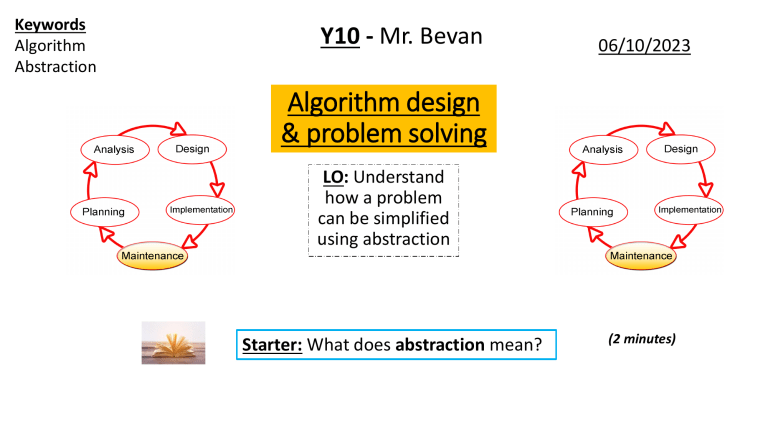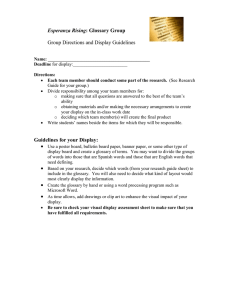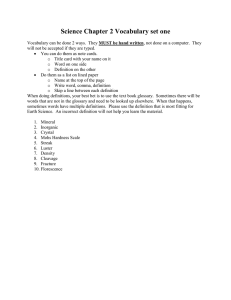
Keywords Algorithm Abstraction Y10 - Mr. Bevan 06/10/2023 Algorithm design & problem solving LO: Understand how a problem can be simplified using abstraction Starter: What does abstraction mean? (2 minutes) Answers Starter: Abstraction is the idea of taking something real or physical and breaking it down into its most important ideas or elements. Abstract art is defined by the Tate gallery as ‘artworks that do not attempt to represent an accurate depiction of a visual reality, but instead use shapes, colours, forms and gestural marks to achieve its effect’. Today we will be looking at an overview of the program development lifecycle is and how to remove unnecessary elements from programs so that they are easier to define. We will start with an example of when abstraction was used in the 1930s to create a simplified map. Q1. Does anyone know what this is a map of? Q1. The London Underground subway in the 1920s. In the 1920s the underground was expanding at a fast rate and more routes were getting added year by year. The problem was, the map that was designed was getting a bit too difficult to read. The stations were quite far apart and it was difficult to read those in the centre. It was also not an efficient design. There were large areas (highlighted in green) that were not really needed. So, in 1926, a map-maker was employed in order to make the map simpler to read. He removed the unnecessary areas, and put regular spacing between the stations to make it look nicer. While this meant that it could not be superimposed on a map, they found that overall customers were more interested in: - Getting from one station to another in the simplest way - Seeing all available routes easily This is the version introduced in 1936 by Harry Beck. Not much has changed since then. So, what has this got to do with computer science? Well: - Unnecessary elements were removed that were not relevant or distracted from more important elements This is what abstraction is in computer science. Write this definition down into your glossary document. Task 1: Write the definition for “abstraction” down into your glossary document. So, what is the program development life cycle? Well, it looks like this. For this specification, we are not worried about maintenance though. So, do not worry about that. Just: - Analysis - Design - Implementation/testing - Planning Analysis The analysis stage is also called the ‘requirements specification’ stage. It is where the problem is clearly defined. In software engineering, this is called the: - Software Requirements Specification (SRS) During this phase, tools such as decomposition and abstraction are used to perform the analysis. The next slide shows an example of a SRS. General More detailed Q2. Can you think of any reasons why it is very important to have a clearly defined SRS? A2. See below for the main ones. - Before a project is started, everything is clear for all parties. E.g. The company performing the work understands what is required of them, and the client (the person requesting work) understands what the company will deliver. This means everyone is happy and knows exactly what is expected before the work commences. - There is minimal chance of people getting annoyed The more transparent the SRS, the less likely each party will get annoyed with what is delivered. Again, so long as the SRS is checked and validated thoroughly before any work commences, it will lead to good outcomes for both parties. Decomposition Even everyday tasks can be broken down into their constituent parts. For example, just the process of putting your clothes on can be broken down into quite a few steps that you may not have thought of!: - Select clothes to wear - Remove any clothes currently on - Put on clothes in correct order! You may think that these are easy decisions to make, but some people know the effects of making too many decisions. There have been many books produced about the effect of this. For instance, for some people they would rather not think about step number 1 at all ‘Select clothes to wear’. Q3. Why do some successful people choose to wear the same clothes every day? Q3. Because every extra decision you make contributes to a phenomenon known as ‘decision fatigue’. If you have to make too many decisions each day then you are more likely to suffer from something called ‘decision fatigue’. This is where the quality of your decisions deteriorates throughout the day. This is the reason why big companies often have their most important meetings in the morning, while everyone has still got a ‘clear’ mind! (Don’t worry, this will not be assessed in your Computer Science exam). This is a great book that explains decision fatigue in a bit more detaill. https://www.rightattitude s.com/2020/01/20/avoiddecision-fatigue/ Write this definition down into your glossary document. Task 3: Write the definition for “decomposition” down into your glossary document. That is it for the analysis stage for now. Let’s write this definition down too. Task 4: Write the definition for “analysis” down into your glossary document. Design In the design stage the requirements from the analysis stage are looked at in more detail. From the requirements, a plan is constructed that involves how to achieve these requirements. This often involves the use of structure charts, flowcharts and pseudocode. Let’s have a look at these in a bit more detail. Structure charts/diagrams This is an example of a structure chart. Structure charts come in many different types depending on the type of product to be developed. Notice they typically just use rectangle boxes. Often they are heirarchical, meaning that they typically start at the top and branch down. Task 5: Write the definition for “structure diagram” down into your glossary document. Flowcharts This is an example of a flowchart. Q4. Can you see one difference between a structure diagram and a flowchart? A4. Flowcharts use different symbols depending on the type of task. This is an example of a flowchart from a past paper question. Notice the different types of boxes used. Let’s see a quick overview of what the symbols mean. We will discuss them more in a future lesson though. Pseudocode Q5. Does anyone know what pseudocode is? A5. Pseudocode is a general language that we can use to design software. Although it is not an actual language that we can write into a computer and test, it is useful since it can be understood by everyone, regardless of their background. You will need to understand how to write pseudocode in order to do well in the assessment. Although you can never test it, like by writing Python into a computer, you will soon understand its syntax and use. Task 6: Write the definition for “pseudocode” down into your glossary document. Implementation/testing In this spec the third stage is called testing. This is where the software is tested using a process known as iteration. Q6. Does anyone know what iteration is? A5. The process of testing and retesting until you get closer and closer to a required goal. For example, in AI models, lots of data is collected through different channels. In the example to the right, someone is trying to train an AI to beat his score at Trackmania. He starts by giving the software a reward, just like a human. The software then tries all the possible combinations and iterations until it finds the optimum path. The software beats his score in the end! https://www.youtube.com/watch?v=Dw3BZ6O_8LY Testing also includes not just iteration, but user input too. If you are designing for example a website, you may want to ask as many people as possible to try using the website for a period of time. You would ask them to inform the company if you experience any issues along the way. If something needs changing Last glossary term! Task 7: Write the definition for “testing” down into your glossary document.



